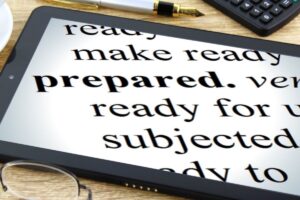Classroom Management
Effective classroom management begins before school starts. There are many things to consider when developing a classroom management plan, and the better prepared you are with that plan, the better it will work for you.
Lack of advance planning will ultimately waste instructional time, exhaust you as the teacher, and fail to create an environment where your students can effectively learn.
Being prepared on the first day of school is going to allow you to approach the day with a calm demeanor and help you convey a sense of control to your students. This is an important first impression to make. If on the first day of school you instead choose to ‘wing it’, those savvy students will pick up on it and you are starting the year in a hole. So, I cannot emphasize enough that you need to be prepared with your plan before the first day of school.
Following is a list of things for you to consider as you develop your plan:
Develop Procedures
Following are a list of questions to help you think through some basic procedures in your classroom. Once you’ve answered all of these questions, and considered other things that may not be on this list, determine how you’ll share this with students. Will you use a handout? Will you review procedures with a digital presentation? Will you create anchor charts? Whatever methods you choose, have it ready before school starts.
- How do you want students to enter the classroom?
- What should students do with their backpacks? With their coats or other personal belongings?
- What do you want students to do when the bell rings?
- Will you assign homework? If so, what are the procedures for turning it in?
- How will classroom supplies be handled, including paper, pencils, books, and other supplies?
- What should students do if they need to leave their seat for something?
- What should students do when they finish their work early?
- What attention getters are you going to use?
- How will you collect papers during class?
- What will the policies be for digital devices? (Be sure to conform to any district or school policies)
- How will students exit the classroom?
- Will you involve students in making any of these decisions as opposed to making all the decisions on your own? If so, devise a strategy for accomplishing that as soon as school starts. You cannot delay; the lack of a plan will become a problem quickly.
This list is just a starting point. Truthfully, anytime you want something done and that something is going to happen pretty often, you need to establish a procedure for it and students need to know what that procedure is.

Develop Behavior Expectations and a Relevant Discipline Plan
A well-managed classroom typically has very few behavior or discipline issues. Still, it’s important to plan for the expectations and consequences so that your students know what the expectations are and clearly understand the consequences. Here are some key areas to consider:
What are your non-negotiable expectations for student behavior? This isn’t an exhaustive list of do’s and don’ts. These are high level behaviors that you expect students to exhibit. Some common areas that you might establish expectations for include:
- Attitude (for example: Students will demonstrate a positive attitude in this classroom.)
- Respect (for example: Students will treat their peers and their teacher with respect.)
- Integrity (for example: Students will demonstrate integrity in their words and actions.)
- Principles (for example: Students will do the right thing when confronted with a choice between right and wrong.)
- Kindness (for example: Students will treat their classmates and their teacher with kindness.)
- Engagement (for example: Students will make the effort required to learn.)
- Responsibility (for example: Students will take responsibility and accept consequences for their actions.)
- Safety (for example: Students will behave in a way that keeps them and their classmates safe.)
A list of positive behavior expectations is better than a laundry list of do’s and don’ts because it makes that list moot. Almost every rule you might list will fall under one of these headings. Think about a rule that says students will be on time to class. That falls both under demonstrating respect and under engagement.
It’s okay to set lofty behavior expectations here. Teachers who expect a lot of their students (consistently demonstrating that expectation) will get a lot from their students.
After you’ve created a succinct list of classroom behavior expectations, determine how you will gain student compliance with those behaviors. This can include incentives as well as consequences. Just remember to be reasonable in your plan and not to paint yourself into a corner by saying you’ll do something that you really don’t want to or won’t do. Students perceive those kinds of things as you playing “King of the Mountain” and there is nothing they love to do more than knock the king off the mountain.
I’d like to encourage you to avoid whole-class consequences where possible. I know the power of threatening to take away recess and I know the intention is to get kids to pull their classmates in-line. But my perception of this type of consequence is that it is unfair to those students who are meeting expectations. If that’s my perception, it’s probably the students’ perception as well. Try to think of alternatives to whole-class consequences. For instance, if you teach elementary school and your children enjoy recess, instead of taking recess away from the whole class, identify those who are really creating the problem and have them sit on the side-lines while other students enjoy their break. Being fair is important to your classroom culture and to effective classroom management.
Both your list of behavior expectations and the incentives and/or consequences need to be clearly evident to students. How are going to present them? How are you going to keep them front of mind?
You might choose to engage students in working together to create this list of classroom expectations. That’s a wonderful idea and does help create a sense of community in the classroom. If you choose to do that, be sure to do it right at the beginning of the school year for reasons already mentioned. You will also want to know what your non-negotiables are ahead of time so that if students don’t add them to the list you can do so. Creating community is important, but don’t forget that you are the teacher and ultimately you are in charge. I would recommend additional reading on that specific strategy before you utilize it in your classroom.

Expectations of the Teacher
It’s a good idea and sets the right tone to also prepare ahead of time a list of behaviors and responsibilities that students can expect of you as the teacher. That might include things like preparing engaging lessons, keeping the classroom safe, being fair in grading practices, including everyone in classroom activities, being kind and respectful when speaking to students, etc.
Just like it’s okay to set lofty expectations for students, you can set lofty expectations for yourself. Showing students how you meet those expectations is a wonderful model of appropriate behavior that they may not get anywhere else.
This is another place where you might want to give students a voice early on. You can even approach this as an example of fairness and respect. You set expectations for them; they likewise should expect certain things of you.

Classroom Management is More than Expectations and Rules
Although it’s beyond the scope of this article, it’s important to note that there are many other things that need to be prepared before the start of the school year to get off to a successful start. Things like your lesson plans and activities, supplies, having the classroom set-up and organized, determining how you’ll greet students, and more. These are typical things teachers get ready for the school year, but here we are emphasizing them as part of effective classroom management. Having the classroom in order and showing up prepared on the first day and every day after that is a big part of effectively managing your classroom.
In the next article in this series, we’ll talk about how to train students on classroom procedures and expectations. Follow us on social media or subscribe to our newsletter to be sure you don’t miss an installment in this series!
